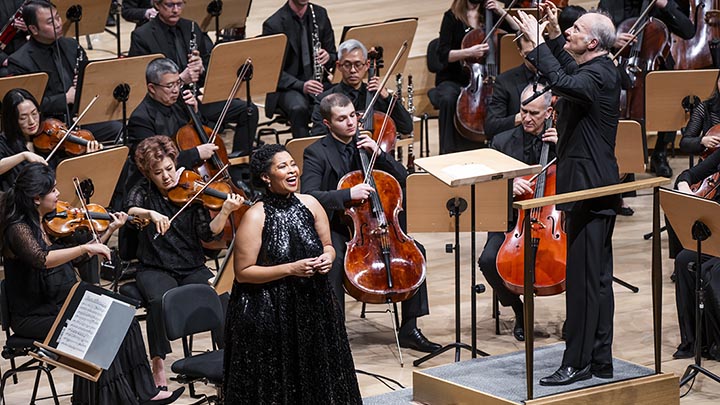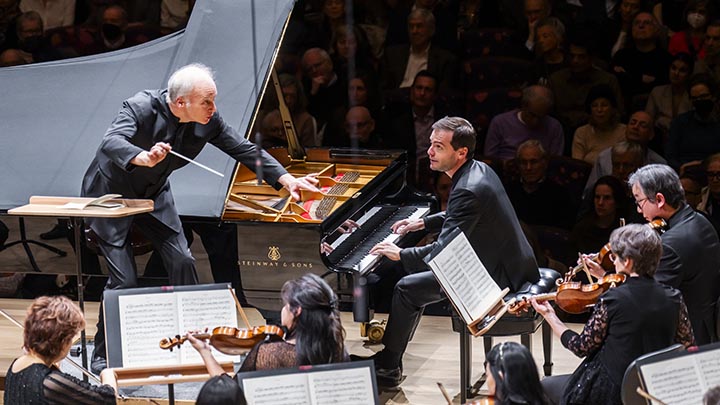
The New York Philharmonic paired the classic Mozart concert aria “Ch’io mi scordi di te” with Mahler’s Symphony No. 4 in G Major, in order to show off the silver-toned soprano of Golda Schultz. The two works would allow the singer to demonstrate different aspects of her interpretive portfolio—righteous indignation in the earlier piece, heavenly repose in the latter—as well as varied vocal styles as she would move from florid passagework to cleanly phrased, well-articulated lieder. Between these vocal showcases, the audience also received Mozart’s K503 Piano Concerto featuring Swiss soloist Francesco Piemontesi.
At the second of three performances last week, Schultz brought an admirable innocence to
“Das himmlische Leben,” the song that anchors the fourth movement of Mahler’s symphony, projecting a childlike innocence that didn’t turn cloying. She traced the text’s images of Heaven from a juvenile’s point of view with near-native German fluency, such that even a non-speaker could parse literal meaning almost without the aid of supertitles. Yet the interpretation mostly lingered on one note throughout the piece, without delving much into the wry, ironic subtext of the work.
The song depicts a child’s wonderment at the bounties of Heaven, which could never be replicated on Earth—but this is, after all, still a dead child. This Heaven, too, features the imagery of slaughtered animals and children toiling through hard labor. Much of these dimensions were lost in Schultz’s sunny, serene version. A soupçon of sardonic wit can complement the humorous dichotomies that Mahler baked into the rest of the symphony, where he constantly juxtaposes high and low musical styles, further developing his unique symphonic language. Although Schultz should be applauded for her beauty of tone, I wanted darker waters beneath the placid surface.
Conductor Gianandrea Noseda favored extremely fast tempi throughout the concert, and in the Mahler, his need for speed often bulldozed through the detail of the score. The first movement drips with an Alpine folksiness, achieved through sleigh bells and silvery flutes, but the effect sounded overly kitschy here, like a tune heard from a music box. Despite some singular contributions from individual section players—the vibrant clarinet of Anthony McGill, the elegance of guest principal horn Jennifer Montone—the movement passed without much distinction. In the second, the rustic violin solos sounded downright tame in the hands of concertmaster Frank Huang, who seemed primarily interested in keeping up.
Overall, the performance lacked the elements that draw many to Mahler: extremities of tempo and dynamics, subtle passages that build to blazing climaxes, and a sense of individuality in the writing that still persists. It was a reading short on ideas, where everything more or less blended together.
Before that, Noseda turned “Ch’io mi scordi di te” into a steeple chase. It’s possible that excessive rubato may now be viewed as too much of a Romantic throwback in Mozart, but I doubt the answer is to simply employ none. Schultz coped commendably with the lightning-fast demands, but they led again to a rather invariant interpretation. There were other questionable choices: Why did Noseda permit a cadenza for Piemontesi (acting as piano accompanist here) but not for his soprano?
In the C Major Piano Concerto, Piemontesi delivered maximum flash but minimal sparkle. Again, Noseda eschewed rubato entirely, and you couldn’t help but marvel at the soloist’s ease in keeping up. But the performance lacked much in the way of wit, even in surefire moments like the first-movement theme that often strikes modern listeners as an allusion to the Marseillaise (It’s not.). And the excessively bright and brilliant acoustic of David Geffen Hall made plain some intonation issues within the orchestra, which were particularly apparent in the flute and bassoon here.
In the decades since historically informed performances practices have come to dominate the conversation around Mozart interpretation, I’ve wondered whether large-scale orchestras have taken away the wrong lessons, leading to readings of this music that are too fast, too thin, and too generic. Unfortunately, that seemed to be the case here.
Photos: Chris Lee



























Comments